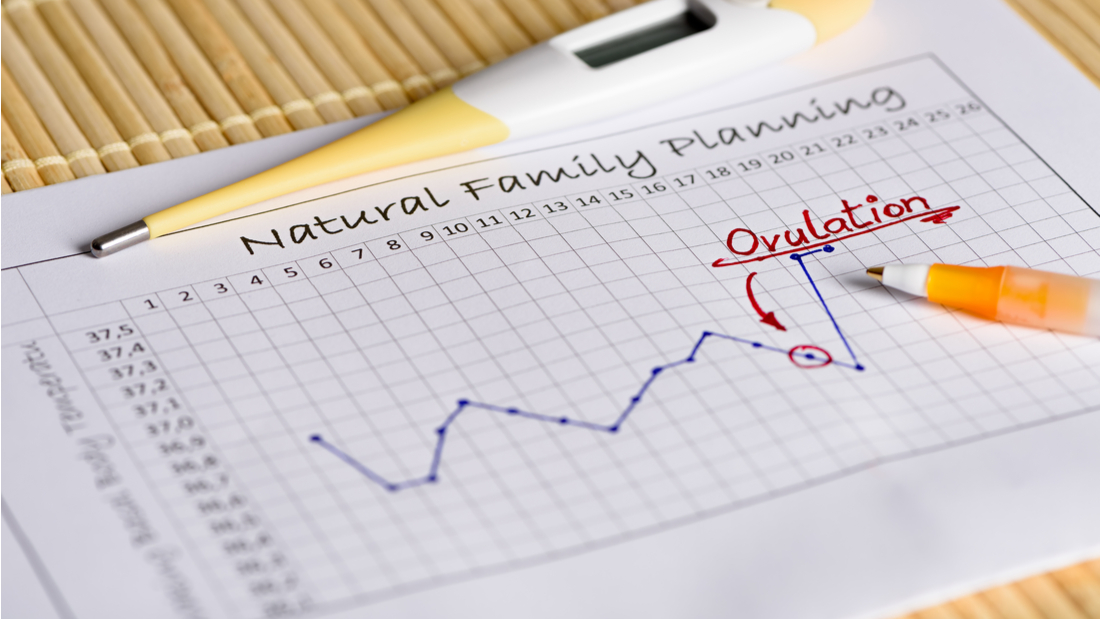Tracking ovulation
In this article:
- Understanding your menstrual cycle
- Why is ovulation important?
- Length of cycle
- Cervical mucus
- Basal body temperature
- Ovulation tests
- Main points

Understanding your menstrual cycle
If you are trying to conceive, it is important to have knowledge of the length of your menstrual cycle, when ovulation happens, and when your fertile window is. If you don’t know this, you can still have regular sexual intercourse 2-3 times per week throughout your cycle to try and get pregnant. However, if you want to work out when the best time to get pregnant is, it’s worth trying to understand when you ovulate. Here we discuss all the different methods to track ovulation.
Why is ovulation important?
When the egg is released, it travels down the fallopian tube where it needs to meet sperm in order to be fertilised. The egg can only survive for 12 to 24 hours after release so there is a relatively short window for fertilisation to take place. The key therefore, is to ensure that intercourse is timed so that there is sperm already waiting in the fallopian tube to meet the egg. Luckily sperm has been shown to survive for up to 5 days so you can actually start having sex up to 5 days before ovulation. So if you know when ovulation is, you can maximise your chance of getting pregnant by having sex in the lead up to it, i.e. your fertile window.
Length of cycle
Your cycle starts on the first day of your period and lasts until the day before the next period starts. We used to think that the average woman had a 28-day cycle but actually recent research shows that this textbook figure is only seen in 13% of women. A normal cycle is anywhere between 21 and 35 days. Ovulation happens about 14 days before your next period. So, in a 28-day cycle this is on day 14, but in a 35-day cycle this is on day 21. Using this information, you can monitor the length of your menstrual cycle and get an idea of when you ovulate. You can also use an ovulation calculator to keep on top of this for you!
Cervical mucus
This is nature’s way for you to know when ovulation is happening. The cervix is always producing discharge but its consistency and colour changes in response to the hormonal changes of the menstrual cycle.
To track ovulation using cervical mucus, start assessing the mucus on the day after your period stops. It’s best to chart every day until your next period to really get to know the different types of mucus. To do this, insert a clean finger into the vagina as high as possible. Note the colour (white, clear, cloudy), amount (a little, a lot, none), consistency (thick, sticky, stretchy) and texture (dry, wet, slippery).


At the end of your period and as hormone levels rise in preparation for ovulation, you may find that discharge becomes thicker, creamier and sticky. In the fertile window, cervical mucus becomes more watery. At your most fertile, the mucus is abundant, stretchy and clear like raw egg whites signalling that ovulation is likely to happen in the next 1-2 days. This type of mucus makes it easier for sperm to travel through the cervix in order to get to the fallopian tubes. Once ovulation has happened, cervical mucus will dry up and become less profuse.
It might feel a little unnatural initially, but with practice you will become familiar with your own patterns of cervical mucus.
Basal body temperature
After the egg is released at ovulation, the remaining empty follicle, or corpus luteum, starts to produce progesterone. This hormone acts on the brain to cause a very small increase in temperature, usually only half a degree. This is the change you are looking for when you look for ovulation using temperature. However, in order to detect this change, you need to know what your everyday “normal” temperature is – this is your basal body temperature. Because the change is so small, you need an accurate digital thermometer or specific family planning thermometer to use this method. You can’t rely on normal ear or forehead thermometers as they cannot measure this small change. Also, your temperature can be affected by many things, e.g. exercise or drinking a warm drink. Therefore, there are some rules to follow to get reliable and comparable results:
- Start recording your temperature on the first day of your cycle, i.e. the first day of your period. Try to record every day of your cycle and note the temperatures in a chart.
- The temperature from the first five days of your cycle is your basal body temperature.
- Always measure your temperature first thing in the morning, before you get out of bed or have anything to eat or drink.
- Watch for an increase in temperature which indicates you have ovulated. This higher temperature usually lasts for three days.
Temperature tracking requires sticking to the rules otherwise you’re very unlikely to reliably detect the small increase in temperature. As such, it’s also prone to errors, e.g. illness, poor sleep, jet lag and alcohol can all affect the temperature readings.
More importantly, unlike the calendar method and cervical mucus tracking, using the basal body temperature method can only tell you when ovulation has already happened! By the time you’ve detected the change, you’ve already passed the most fertile days in your cycle. But, if you have regular cycles, you can use the information to predict when you ovulate each month and time sex accordingly.
Ovulation tests
These tests can be bought at any pharmacy and look and function just like a home pregnancy test. They work by testing for LH (luteinising hormone), a hormone that spikes sharply just before ovulation. The test will usually come with instructions and between five and seven sticks for you to use one each day in the run-up to ovulation. If the test is positive and detects a high level of LH, you can predict that ovulation will happen in the next 16-48 hours. This is the ideal time to have intercourse. Some tests also check for a rising level of oestrogen which will give you a few more days of “higher fertility” to have intercourse on, but this isn’t necessary if you are having sex every two to three days anyway.
The tests aren’t 100% reliable, however, as studies have shown that urine LH levels may be slower to rise compared to blood LH levels. If you only rely on urine LH therefore, ovulation may actually be occurring earlier than you think. So while the tests are good indicators of rough windows of ovulation, you should still try to have sex every 2-3 days in the fertile window.
Read more information on issues with ovulation and hormones and the monthly cycle.
Main points
- If you want to work out when is the best time to get pregnant and calculate the date of ovulation, you can use an ovulation calculator, or you can identify the signs and symptoms of ovulation yourself.
- You can predict ovulation, and therefore the best time to get pregnant, by tracking factors such as the length of your cycle, your body temperature, and the texture and volume of cervical mucus.
- There is a small rise in body temperature after ovulation and a digital thermometer (or a specific family planning thermometer) can measure when you have ovulated.
- The texture and volume of cervical mucus changes during different points in your menstrual cycle, becoming thicker at the most fertile stage of your cycle.



